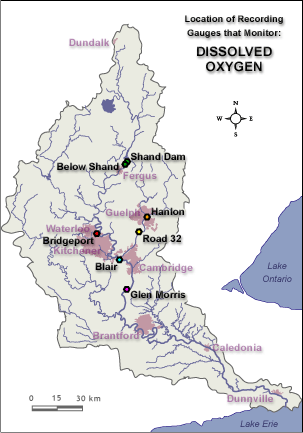Dissolved Oxygen
Dissolved oxygen is the concentration of free molecular oxygen dissolved in water, usually expressed in milligrams per liter, parts per million, or percent of saturation.
Fish, bugs and other aquatic organisms need dissolved oxygen. If there is too little in the water, they will suffocate and die. It’s best if dissolved oxygen levels are above five milligrams of oxygen per litre of water (mgO2/L). Most fish cannot survive if levels are below three milligrams per litre for an extended period. When levels drop below one milligram per litre, the water is called hypoxic. When there is no oxygen, it is anoxic or anaerobic.
The amount of dissolved oxygen in the river water can be affected by several factors and processes going on in the river. Aquatic plants have a big impact on oxygen levels. Plants produce dissolved oxygen during the day and consume oxygen overnight so there can be swings in oxygen levels over the course of the day.
When there are too many plants in a river or stream, oxygen levels can drop so low overnight that aquatic creatures leave the area.
- Learn how to read our River and stream flow charts, and our Reservoir charts.
- Many timeseries can be downloaded from our Data Downloads page.

Provisional Data
Caution: Users of the GRCA's real-time data are cautioned to consider the provisional nature of the information before using it for decisions that concern personal or public safety or the conduct of business.
The Grand River Conservation Authority assumes no responsibility for the correctness of the information contained in this website nor liability to any user of such information, regardless of the purpose.
Warning! River levels and flows can change rapidly.
Contact Us
Grand River Conservation Authority
400 Clyde Road, PO Box 729
Cambridge, ON
N1R 5W6
Phone: 519-621-2761
Toll Free: 1-866-900-4722
grca@grandriver.ca
